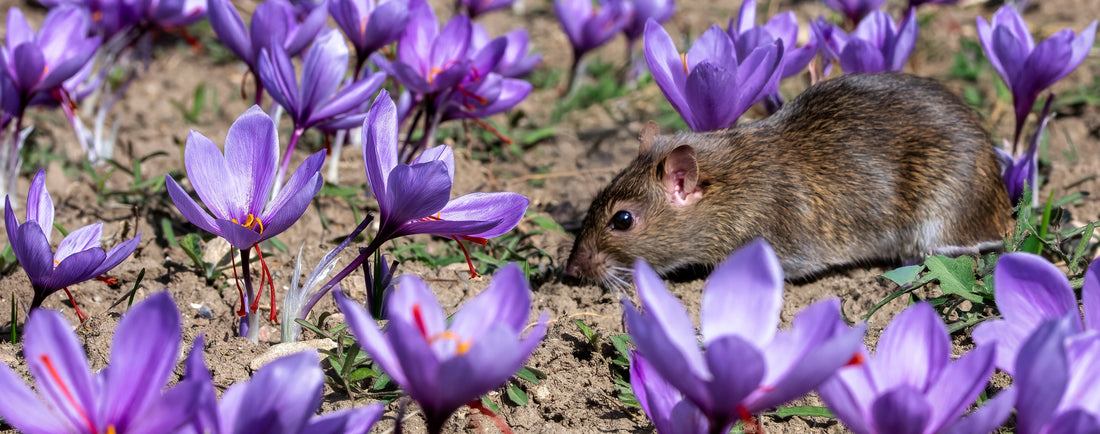
How to avoid rodents in saffron farming
Share
Rodents—especially mice, voles, and gophers—pose a serious threat to saffron farmers. These small animals are particularly attracted to the nutrient-rich corms of Crocus sativus and can cause widespread damage underground before you even notice the signs. If left unchecked, rodents can reduce your saffron yield, disrupt your planting beds, and shorten the productive lifespan of your field.
In this article, we’ll explore practical, effective, and natural strategies to prevent rodents in saffron farming.
Why rodents are a problem for saffron growers
Rodents are drawn to saffron fields for a few key reasons:
- Corms are a food source: Corms are starchy and rich in nutrients, making them a prime target;
- Soft, undisturbed soil: Saffron beds are often left undisturbed for several years, creating a cozy habitat for burrowing;
- Dry periods: During dormancy (July–August), corms sit undisturbed and unprotected underground.
Rodents may eat or hollow out corms, killing the plant or weakening future growth. They can also create tunnel systems that dry out the soil or damage the field’s structure.
Signs of rodent activity in saffron fields
Be on the lookout for:
- Small holes or tunnels near your saffron rows;
- Disturbed soil or collapsed planting beds;
- Missing or rotting corms during inspection;
- Droppings, tracks, or chewed vegetation nearby.
Early detection is crucial to prevent larger infestations.
Natural ways to prevent rodents in saffron farming
Here are some of the most effective, sustainable strategies to keep rodents out of saffron beds:
1. Encourage natural predators
Attract owls, hawks, snakes, and barn cats to your fields. Installing owl boxes or perches can help control rodent populations naturally. Cats (especially farm cats) are highly effective in keeping small mammals at bay.
2. Maintain clean field borders
Rodents love overgrown field edges. Mow or clear surrounding areas to reduce rodent cover and make it harder for them to approach unnoticed.
3. Use physical barriers
Consider planting saffron in raised beds with underground mesh (like hardware cloth) to block rodents from burrowing up into the corms. If feasible, bury metal mesh 20–30 cm deep around plots as a rodent fence.
4. Interplant with rodent-repellent plants
Some plants naturally deter rodents. Try interplanting saffron with:
- Mint
- Garlic
- Daffodils (narcissus) – highly toxic to rodents
- Fritillaria imperialis – a strong-smelling bulbous plant rodents avoid
These natural barriers can help mask the scent of Crocus sativus corms.
5. Avoid organic mulch in active seasons
Organic mulch like straw or leaves can create nesting material for rodents. Use gravel or leave the surface bare during growing months to make it less attractive.
6. Minimize food sources nearby
Keep nearby grain stores sealed and remove fallen fruits, seeds, or compost piles that may attract rodents near your field.
7. Use natural repellents
Commercial or homemade rodent repellents using castor oil, peppermint oil, or garlic can be applied around planting beds. These are non-toxic but must be reapplied regularly, especially after rain.
8. Regular field inspections
Walk your fields regularly—especially near planting and dormancy periods—to spot burrows, tunnels, or signs of chewing. Early intervention is key to preventing large infestations.
What to avoid: rodent control mistakes
- Avoid toxic rodenticides: they can harm pets, wildlife, and the soil microbiome;
- Don’t wait until signs of damage appear: rodents multiply fast;
- Don’t assume winter dormancy protects your corms: many rodents are active year-round underground.
